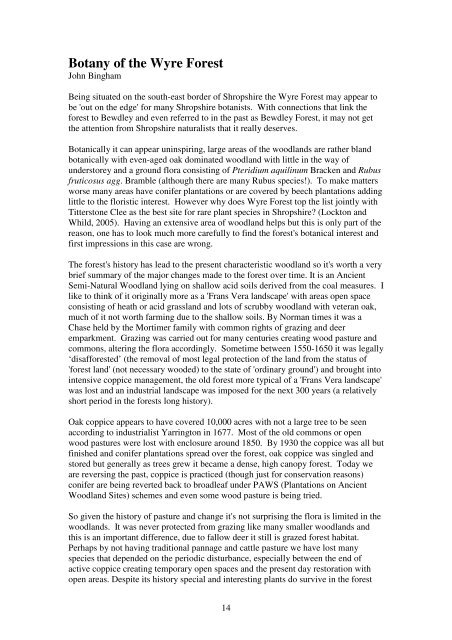Shropshire Botanical Society Newsletter - Botanical Society of the ...
Shropshire Botanical Society Newsletter - Botanical Society of the ...
Shropshire Botanical Society Newsletter - Botanical Society of the ...
You also want an ePaper? Increase the reach of your titles
YUMPU automatically turns print PDFs into web optimized ePapers that Google loves.
Botany <strong>of</strong> <strong>the</strong> Wyre ForestJohn BinghamBeing situated on <strong>the</strong> south-east border <strong>of</strong> <strong>Shropshire</strong> <strong>the</strong> Wyre Forest may appear tobe 'out on <strong>the</strong> edge' for many <strong>Shropshire</strong> botanists. With connections that link <strong>the</strong>forest to Bewdley and even referred to in <strong>the</strong> past as Bewdley Forest, it may not get<strong>the</strong> attention from <strong>Shropshire</strong> naturalists that it really deserves.<strong>Botanical</strong>ly it can appear uninspiring, large areas <strong>of</strong> <strong>the</strong> woodlands are ra<strong>the</strong>r blandbotanically with even-aged oak dominated woodland with little in <strong>the</strong> way <strong>of</strong>understorey and a ground flora consisting <strong>of</strong> Pteridium aquilinum Bracken and Rubusfruticosus agg. Bramble (although <strong>the</strong>re are many Rubus species!). To make mattersworse many areas have conifer plantations or are covered by beech plantations addinglittle to <strong>the</strong> floristic interest. However why does Wyre Forest top <strong>the</strong> list jointly withTitterstone Clee as <strong>the</strong> best site for rare plant species in <strong>Shropshire</strong>? (Lockton andWhild, 2005). Having an extensive area <strong>of</strong> woodland helps but this is only part <strong>of</strong> <strong>the</strong>reason, one has to look much more carefully to find <strong>the</strong> forest's botanical interest andfirst impressions in this case are wrong.The forest's history has lead to <strong>the</strong> present characteristic woodland so it's worth a verybrief summary <strong>of</strong> <strong>the</strong> major changes made to <strong>the</strong> forest over time. It is an AncientSemi-Natural Woodland lying on shallow acid soils derived from <strong>the</strong> coal measures. Ilike to think <strong>of</strong> it originally more as a 'Frans Vera landscape' with areas open spaceconsisting <strong>of</strong> heath or acid grassland and lots <strong>of</strong> scrubby woodland with veteran oak,much <strong>of</strong> it not worth farming due to <strong>the</strong> shallow soils. By Norman times it was aChase held by <strong>the</strong> Mortimer family with common rights <strong>of</strong> grazing and deeremparkment. Grazing was carried out for many centuries creating wood pasture andcommons, altering <strong>the</strong> flora accordingly. Sometime between 1550-1650 it was legally‘disafforested’ (<strong>the</strong> removal <strong>of</strong> most legal protection <strong>of</strong> <strong>the</strong> land from <strong>the</strong> status <strong>of</strong>'forest land' (not necessary wooded) to <strong>the</strong> state <strong>of</strong> 'ordinary ground') and brought intointensive coppice management, <strong>the</strong> old forest more typical <strong>of</strong> a 'Frans Vera landscape'was lost and an industrial landscape was imposed for <strong>the</strong> next 300 years (a relativelyshort period in <strong>the</strong> forests long history).Oak coppice appears to have covered 10,000 acres with not a large tree to be seenaccording to industrialist Yarrington in 1677. Most <strong>of</strong> <strong>the</strong> old commons or openwood pastures were lost with enclosure around 1850. By 1930 <strong>the</strong> coppice was all butfinished and conifer plantations spread over <strong>the</strong> forest, oak coppice was singled andstored but generally as trees grew it became a dense, high canopy forest. Today weare reversing <strong>the</strong> past, coppice is practiced (though just for conservation reasons)conifer are being reverted back to broadleaf under PAWS (Plantations on AncientWoodland Sites) schemes and even some wood pasture is being tried.So given <strong>the</strong> history <strong>of</strong> pasture and change it's not surprising <strong>the</strong> flora is limited in <strong>the</strong>woodlands. It was never protected from grazing like many smaller woodlands andthis is an important difference, due to fallow deer it still is grazed forest habitat.Perhaps by not having traditional pannage and cattle pasture we have lost manyspecies that depended on <strong>the</strong> periodic disturbance, especially between <strong>the</strong> end <strong>of</strong>active coppice creating temporary open spaces and <strong>the</strong> present day restoration withopen areas. Despite its history special and interesting plants do survive in <strong>the</strong> forest14
















